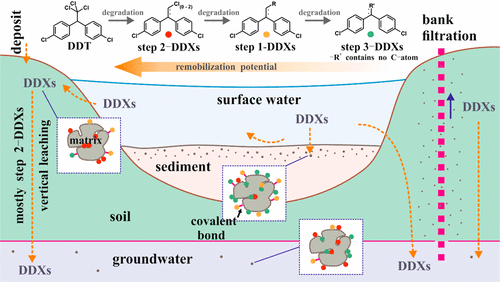当前位置:
X-MOL 学术
›
Environ. Sci. Technol.
›
论文详情
Our official English website, www.x-mol.net, welcomes your
feedback! (Note: you will need to create a separate account there.)
Formation and Fate of Point-Source Nonextractable DDT-Related Compounds on Their Environmental Aquatic-Terrestrial Pathway
Environmental Science & Technology ( IF 10.8 ) Pub Date : 2019-01-16 , DOI: 10.1021/acs.est.8b06018 Xiaojing Zhu 1 , Larissa Dsikowitzky 1 , Sebastian Kucher 1 , Mathias Ricking 2 , Jan Schwarzbauer 1
Environmental Science & Technology ( IF 10.8 ) Pub Date : 2019-01-16 , DOI: 10.1021/acs.est.8b06018 Xiaojing Zhu 1 , Larissa Dsikowitzky 1 , Sebastian Kucher 1 , Mathias Ricking 2 , Jan Schwarzbauer 1
Affiliation

|
Nonextractable residues (NER) are pollutants incorporated into the matrix of natural solid matter via different binding mechanisms. They can become bioavailable or remobilize during physical–chemical changes of the surrounding conditions and should thus not be neglected in environmental risk assessment. Sediments, soils, and groundwater sludge contaminated with DDXs (DDT, dichlorodiphenyltrichloroethane; and its metabolites) were treated with solvent extraction, sequential chemical degradation, and thermochemolysis to study the fate of NER-DDX along different environmental aquatic-terrestrial pathways. The results showed that DDT and its first degradation products, DDD (dichlorodiphenyldichloroethane) and DDE (dichlorodiphenyldichloroethylene), were dominant in the free extractable fraction, whereas DDM (dichlorodiphenylmethane), DBP (dichlorobenzophenone), and DDA (dichlorodiphenylacetic acid) were observed primarily after chemical degradation. The detection of DDA, DDMUBr (bis(p-chlorophenyl)-bromoethylene), DDPU (bis(p-chlorophenyl)-propene) and DDPS (bis(p-chlorophenyl)-propane) after chemical treatments evidenced the covalent bindings between these DDXs and the organic matrix. The identified NER-DDXs were categorized into three groups according to the three-step degradation process of DDT. Their distribution along the different pathways demonstrated significant specificity. Based on the obtained results, a conceptual model of the fate of NER-DDXs on their different environmental aquatic-terrestrial pathways is proposed. This model provides basic knowledge for risk assessment and remediation of both extractable and nonextractable DDT-related contaminations.
中文翻译:

点源不可提取的滴滴涕相关化合物在其环境水陆途径中的形成和结局
不可提取的残留物(NER)是通过不同的结合机制掺入天然固体基质中的污染物。它们在周围环境的物理化学变化过程中可能具有生物利用性或迁移性,因此在环境风险评估中不应忽视它们。对DDDs(DDT,二氯二苯基三氯乙烷及其代谢产物)污染的沉积物,土壤和地下水污泥进行了溶剂萃取,顺序化学降解和热化学分解处理,以研究NER-DDX在不同的水生陆地环境路径上的命运。结果表明,DDT及其首批降解产物DDD(二氯二苯基二氯乙烷)和DDE(二氯二苯基二氯乙烯)在游离可萃取馏分中占主导地位,而DDM(二氯二苯基甲烷)在化学降解之后,主要观察到了DBP(二氯二苯甲酮)和DDA(二氯二苯乙酸)。DDA,DDMUBr(bis(对-氯苯基)-溴乙烯),化学处理后的DDPU(双(对氯苯基)-丙烯)和DDPS(双(对氯苯基)-丙烷)证明了这些DDX与有机基质之间的共价结合。根据DDT的三步降解过程,将鉴定出的NER-DDXs分为三类。它们沿不同途径的分布显示出显着的特异性。基于获得的结果,提出了NER-DDXs在其不同的环境水陆途径上的命运的概念模型。该模型为风险评估以及可提取和不可提取的滴滴涕相关污染物的补救提供了基础知识。
更新日期:2019-01-17
中文翻译:

点源不可提取的滴滴涕相关化合物在其环境水陆途径中的形成和结局
不可提取的残留物(NER)是通过不同的结合机制掺入天然固体基质中的污染物。它们在周围环境的物理化学变化过程中可能具有生物利用性或迁移性,因此在环境风险评估中不应忽视它们。对DDDs(DDT,二氯二苯基三氯乙烷及其代谢产物)污染的沉积物,土壤和地下水污泥进行了溶剂萃取,顺序化学降解和热化学分解处理,以研究NER-DDX在不同的水生陆地环境路径上的命运。结果表明,DDT及其首批降解产物DDD(二氯二苯基二氯乙烷)和DDE(二氯二苯基二氯乙烯)在游离可萃取馏分中占主导地位,而DDM(二氯二苯基甲烷)在化学降解之后,主要观察到了DBP(二氯二苯甲酮)和DDA(二氯二苯乙酸)。DDA,DDMUBr(bis(对-氯苯基)-溴乙烯),化学处理后的DDPU(双(对氯苯基)-丙烯)和DDPS(双(对氯苯基)-丙烷)证明了这些DDX与有机基质之间的共价结合。根据DDT的三步降解过程,将鉴定出的NER-DDXs分为三类。它们沿不同途径的分布显示出显着的特异性。基于获得的结果,提出了NER-DDXs在其不同的环境水陆途径上的命运的概念模型。该模型为风险评估以及可提取和不可提取的滴滴涕相关污染物的补救提供了基础知识。































 京公网安备 11010802027423号
京公网安备 11010802027423号